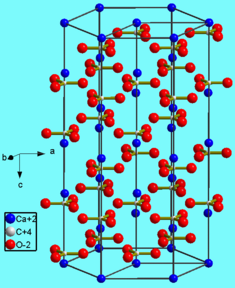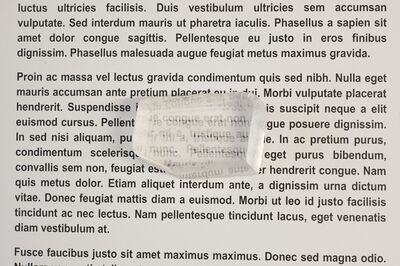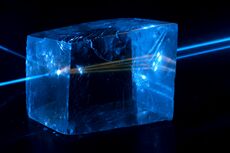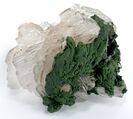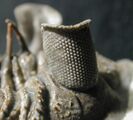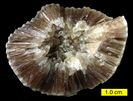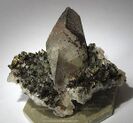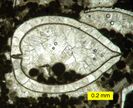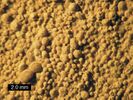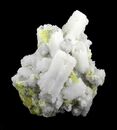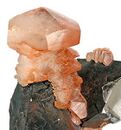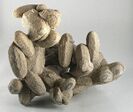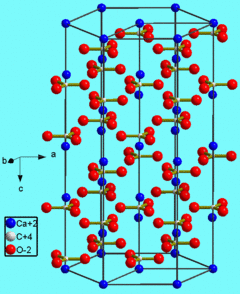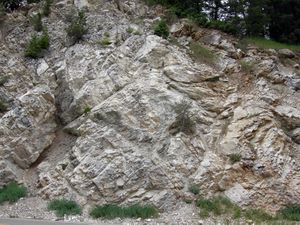كالسيت
| Calcite | |
|---|---|
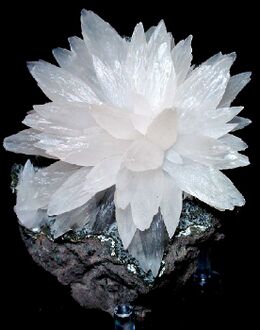 | |
| العامة | |
| التصنيف | Carbonate minerals |
| الصيغة (repeating unit) | CaCO3 |
| تصنيف سترونز | 5.AB.05 |
| النظام البلوري | Trigonal |
| Crystal class | Hexagonal scalenohedral (3m) H-M symbol: (3 2/m) |
| Space group | R3c |
| Unit cell | a = 4.9896(2) Å, c = 17.0610(11) Å; Z = 6 |
| التعرف | |
| Color | Typically colorless or white - may have shades of various colors |
| Crystal habit | Crystalline, granular, stalactitic, concretionary, massive, rhombohedral |
| Twinning | Common by four twin laws |
| Cleavage | Perfect on {1011} three directions with angle of 74° 55'[1] |
| Fracture | Conchoidal |
| Tenacity | Brittle |
| Mohs scale hardness | 3 (defining mineral) |
| Luster | Vitreous to pearly on cleavage surfaces |
| Streak | White |
| Diaphaneity | Transparent to translucent |
| الجاذبية النوعية | 2.71 |
| الصفات البصرية | Uniaxial (−) |
| Refractive index | nω = 1.640–1.660 nε = 1.486 |
| Birefringence | δ = 0.154–0.174 |
| قابلية الانصهار | Infusible (decrepitates energetically)[2] |
| قابلية الذوبان | Soluble in dilute acids |
| سمات أخرى | May fluoresce red, blue, yellow, and other colors under either SW and LW UV; phosphorescent |
| References | [3][4][5] |
الكلسيت Calcite من أكثر المعادن انتشاراً في الأرض. وهو أكثر أشكال كربونات الكالسيوم ثباتاً، وصيغته الكيميائية CaCO3. والكلسيت النقي لا لون له، أو يكون ذا لون أبيض، ولكن يمكن أن يكون الكلسيت بألوان مختلفة أخرى إذا ما وجدت فيه شوائب معدنية أو كميات صغيرة من الكوبالت أو الحديد أو المغنسيوم أو المنجنيز. تنتمي بلورات الكلسيت إلى النظام السداسي. ويمكن تقسيمها إلى معينيات منتظمة الأوجه، وهي أجسام ذات ستة أضلاع، تكون فيها الجوانب سداسية الأضلاع المتقابلة متوازية.
توجد بلورات الكلسيت في أنواع عديدة من الصخور. فالطباشير والحجر الجيري والرخام تحتوي على كميات كبيرة من الكلسيت. وبعض التشكيلات الصخرية مثل الرواسب الكلسية الهابطة من سقوف الكهوف، والرواسب الكلسية الصاعدة في الكهوف، تتكون من نوع من الكلسيت يسمى ترسبات الترافرتين، يقوم الكلسيت بدور المادة اللاصقة للمعادن المختلفة المكونة للصخور الرسوبية الخشنة. والكلسيت هو المصدر الرئيسي في العالم للجير ويستعمل في صناعة العديد من الأشياء، بما في ذلك الزجاج والفولاذ. ويمزج الكلسيت مع المواد الصلصالية لصنع الإسمنت البورتلاندي، ومع الرمال لصنع الملاط. وهناك نوع من الكلسيت غاية في النقاء يدعى "سبار أيسلندا"، يُستعمل في الآلات البصرية مثل المجاهر المستقطبة.
. . . . . . . . . . . . . . . . . . . . . . . . . . . . . . . . . . . . . . . . . . . . . . . . . . . . . . . . . . . . . . . . . . . . . . . . . . . . . . . . . . . . . . . . . . . . . . . . . . . . . . . . . . . . . . . . . . . . . . . . . . . . . . . . . . . . . . . . . . . . . . . . . . . . . . . . . . . . . . . . . . . . . . . .
Properties
The diagnostic properties of calcite include a defining Mohs hardness of 3, a specific gravity of 2.71 and, in crystalline varieties, a vitreous luster. Color is white or none, though shades of gray, red, orange, yellow, green, blue, violet, brown, or even black can occur when the mineral is charged with impurities.[4]
Crystal habits
Calcite has numerous habits, representing combinations of over 1000 crystallographic forms.[3] Most common are scalenohedra, with faces in the hexagonal {2 1 1} directions (morphological unit cell) or {2 1 4} directions (structural unit cell); and rhombohedral, with faces in the {1 0 1} or {1 0 4} directions (the most common cleavage plane).[6] Habits include acute to obtuse rhombohedra, tabular habits, prisms, or various scalenohedra. Calcite exhibits several twinning types adding to the variety of observed habits. It may occur as fibrous, granular, lamellar, or compact. A fibrous, efflorescent habit is known as lublinite.[7] Cleavage is usually in three directions parallel to the rhombohedron form. Its fracture is conchoidal, but difficult to obtain.
Scalenohedral faces are chiral and come in pairs with mirror-image symmetry; their growth can be influenced by interaction with chiral biomolecules such as L- and D-amino acids. Rhombohedral faces are not chiral.[6]
Optical
Calcite is transparent to opaque and may occasionally show phosphorescence or fluorescence. A transparent variety called Iceland spar is used for optical purposes. Acute scalenohedral crystals are sometimes referred to as "dogtooth spar" while the rhombohedral form is sometimes referred to as "nailhead spar".[2] The rhombohedral form may also have been the "sunstone" whose use by Viking navigators is mentioned in the Icelandic Sagas.[8]
Single calcite crystals display an optical property called birefringence (double refraction). This strong birefringence causes objects viewed through a clear piece of calcite to appear doubled. The birefringent effect (using calcite) was first described by the Danish scientist Rasmus Bartholin in 1669. At a wavelength of ≈590 nm calcite has ordinary and extraordinary refractive indices of 1.658 and 1.486, respectively.[9] Between 190 and 1700 nm, the ordinary refractive index varies roughly between 1.9 and 1.5, while the extraordinary refractive index varies between 1.6 and 1.4.[10]
Chemical
Calcite, like most carbonates, will dissolve in acids via the reaction
- CaCO
3(s) + 2H+
(aq) → Ca2+(aq) + H
2O + CO
2(g)
- CaCO
The carbon dioxide released by this reaction produces a characteristic effervescence when dilute hydrochloric acid is dropped on a calcite sample.
Ambient carbon dioxide, due to its acidity, has a slight solubilizing effect on calcite. The overall reaction is
- CaCO
3(s) + H
2O + CO
2(aq) → Ca2+(aq) + 2HCO−
3(aq)
- CaCO
If the amount of dissolved carbon dioxide drops, the reaction reverses to precipitate calcite. As a result, calcite can be either dissolved by groundwater or precipitated by groundwater, depending on such factors as the water temperature, pH, and dissolved ion concentrations. When conditions are right for precipitation, calcite forms mineral coatings that cement rock grains together and can fill fractures. When conditions are right for dissolution, the removal of calcite can dramatically increase the porosity and permeability of the rock, and if it continues for a long period of time, may result in the formation of caves. Continued dissolution of calcium carbonate-rich formations can lead to the expansion and eventual collapse of cave systems, resulting in various forms of karst topography.[11]
Calcite exhibits an unusual characteristic called retrograde solubility in which it becomes less soluble in water as the temperature increases. Calcite is also more soluble at higher pressures.[12]
Pure calcite has the composition CaCO
3. However, the calcite in limestone often contains a few percent of magnesium. Calcite in limestone is divided into low-magnesium and high-magnesium calcite, with the dividing line placed at a composition of 4% magnesium. High-magnesium calcite retains the calcite mineral structure, which is distinct from that of dolomite, MgCa(CO
3)
2.[13] Calcite can also contain small quantities of iron and manganese.[14] Manganese may be responsible for the fluorescence of impure calcite, as may traces of organic compounds.[15]
Use and applications
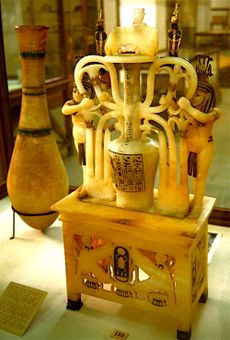
Ancient Egyptians carved many items out of calcite, relating it to their goddess Bast, whose name contributed to the term alabaster because of the close association. Many other cultures have used the material for similar carved objects and applications.[16]
A transparent variety of calcite known as Iceland spar may have been used by Vikings for navigating on cloudy days.[17]
High-grade optical calcite was used in World War II for gun sights, specifically in bomb sights and anti-aircraft weaponry.[18] Also, experiments have been conducted to use calcite for a cloak of invisibility.[19]
Microbiologically precipitated calcite has a wide range of applications, such as soil remediation, soil stabilization and concrete repair.
Calcite, obtained from an 80 kg sample of Carrara marble,[20] is used as the IAEA-603 isotopic standard in mass spectrometry for the calibration of δ18O and δ13C.[21]
Natural occurrence
Calcite is a common constituent of sedimentary rocks, limestone in particular, much of which is formed from the shells of dead marine organisms. Approximately 10% of sedimentary rock is limestone. It is the primary mineral in metamorphic marble. It also occurs in deposits from hot springs as a vein mineral; in caverns as stalactites and stalagmites; and in volcanic or mantle-derived rocks such as carbonatites, kimberlites, or rarely in peridotites.
Calcite is often the primary constituent of the shells of marine organisms, e.g., plankton (such as coccoliths and planktic foraminifera), the hard parts of red algae, some sponges, brachiopods, echinoderms, some serpulids, most bryozoa, and parts of the shells of some bivalves (such as oysters and rudists). Calcite is found in spectacular form in the Snowy River Cave of New Mexico as mentioned above, where microorganisms are credited with natural formations. Trilobites, which became extinct a quarter billion years ago, had unique compound eyes that used clear calcite crystals to form the lenses.[22] It also forms a substantial part of birds' eggshells, and the δ13 C of the diet is reflected in the δ13 C of the calcite of the shell.[23]
The largest documented single crystal of calcite originated from Iceland, measured 7×7×2 m and 6×6×3 m and weighed about 250 tons.[24] Classic samples have been produced at Madawaska Mine, near Bancroft, Ontario.[25]
Bedding parallel veins of fibrous calcite, often referred to in quarrying parlance as "beef", occur in dark organic rich mudstones and shales, these veins are formed by increasing fluid pressure during diagenesis.[26]
Formation processes
Calcite formation can proceed by several pathways, from the classical terrace ledge kink model[27] to the crystallization of poorly ordered precursor phases like amorphous calcium carbonate (ACC) via an Ostwald ripening process, or via the agglomeration of nanocrystals.[28]
The crystallization of ACC can occur in two stages. First, the ACC nanoparticles rapidly dehydrate and crystallize to form individual particles of vaterite. Second, the vaterite transforms to calcite via a dissolution and reprecipitation mechanism, with the reaction rate controlled by the surface area of a calcite crystal.[29] The second stage of the reaction is approximately 10 times slower.
However, crystallization of calcite has been observed to be dependent on the starting pH and concentration of magnesium in solution.[30] A neutral starting pH during mixing promotes the direct transformation of ACC into calcite without a vaterite intermediate. But when ACC forms in a solution with a basic initial pH, the transformation to calcite occurs via metastable vaterite, following the pathway outlined above.[31] Magnesium has a noteworthy effect on both the stability of ACC and its transformation to crystalline CaCO3, resulting in the formation of calcite directly from ACC, as this ion destabilizes the structure of vaterite.
Calcite may form in the subsurface in response to microorganism activity, such as sulfate-dependent anaerobic oxidation of methane, where methane is oxidized and sulfate is reduced, leading to precipitation of calcite and pyrite from the produced bicarbonate and sulfide. These processes can be traced by the specific carbon isotope composition of the calcites, which are extremely depleted in the 13C isotope, by as much as −125 per mil PDB (δ13C).[32]
. . . . . . . . . . . . . . . . . . . . . . . . . . . . . . . . . . . . . . . . . . . . . . . . . . . . . . . . . . . . . . . . . . . . . . . . . . . . . . . . . . . . . . . . . . . . . . . . . . . . . . . . . . . . . . . . . . . . . . . . . . . . . . . . . . . . . . . . . . . . . . . . . . . . . . . . . . . . . . . . . . . . . . . .
In Earth history
Calcite seas existed in Earth's history when the primary inorganic precipitate of calcium carbonate in marine waters was low-magnesium calcite (lmc), as opposed to the aragonite and high-magnesium calcite (hmc) precipitated today. Calcite seas alternated with aragonite seas over the Phanerozoic, being most prominent in the Ordovician and Jurassic periods. Lineages evolved to use whichever morph of calcium carbonate was favourable in the ocean at the time they became mineralised, and retained this mineralogy for the remainder of their evolutionary history.[33] Petrographic evidence for these calcite sea conditions consists of calcitic ooids, lmc cements, hardgrounds, and rapid early seafloor aragonite dissolution.[34] The evolution of marine organisms with calcium carbonate shells may have been affected by the calcite and aragonite sea cycle.[35]
Calcite is one of the minerals that has been shown to catalyze an important biological reaction, the formose reaction, and may have had a role in the origin of life.[6] Interaction of its chiral surfaces (see Form) with aspartic acid molecules results in a slight bias in chirality; this is one possible mechanism for the origin of homochirality in living cells.[36]
Gallery
Calcite with mottramite
Trilobite eyes employed calcite
Calcite crystals inside a test of the cystoid Echinosphaerites aurantium (Middle Ordovician, northeastern Estonia)
Rhombohedrons of calcite that appear almost as books of petals, piled up 3-dimensionally on the matrix
Calcite crystal canted at an angle, with little balls of hematite and crystals of chalcopyrite both on its surface and included just inside the surface of the crystal
Thin section of calcite crystals inside a recrystallized bivalve shell in a biopelsparite
Grainstone with calcite ooids and sparry calcite cement; Carmel Formation, Middle Jurassic, of southern Utah, USA.
Cobaltoan, the cobalt-rich variety of calcite
Sand calcites (calcites heavily included with desert sand) in South Dakota, USA
Calcite, butterfly twin, 4,0 × 3,3 × 1,6 cm. José María Patoni, San Juan del Río, Durango (Mexico)
|
|
انظر أيضًا
- كربونات الكالسيوم
- طباشير
- حجر جيري
- رخام
- ترسبات التراڤرتين
- إيكايت، CaCO3·6H2O
- Manganoan Calcite, (Ca,Mn)CO3
- قائمة المعادن
- Lysocline
- احمضاض المحيط
المصادر
|
للاستزادة
- Schmittner Karl-Erich and Giresse Pierre, 1999. "Micro-environmental controls on biomineralization: superficial processes of apatite and calcite precipitation in Quaternary soils", Roussillon, France. Sedimentology 46/3: 463–476.
وصلات خارجية
| Calcite
]].
